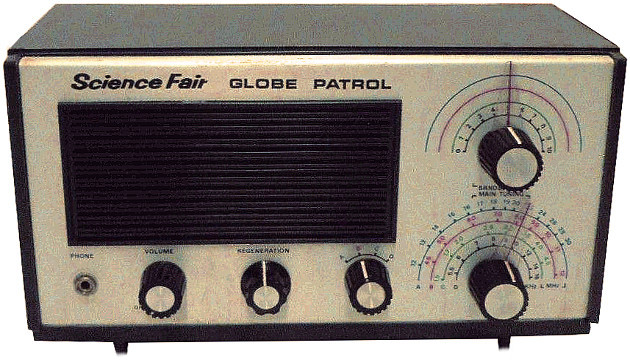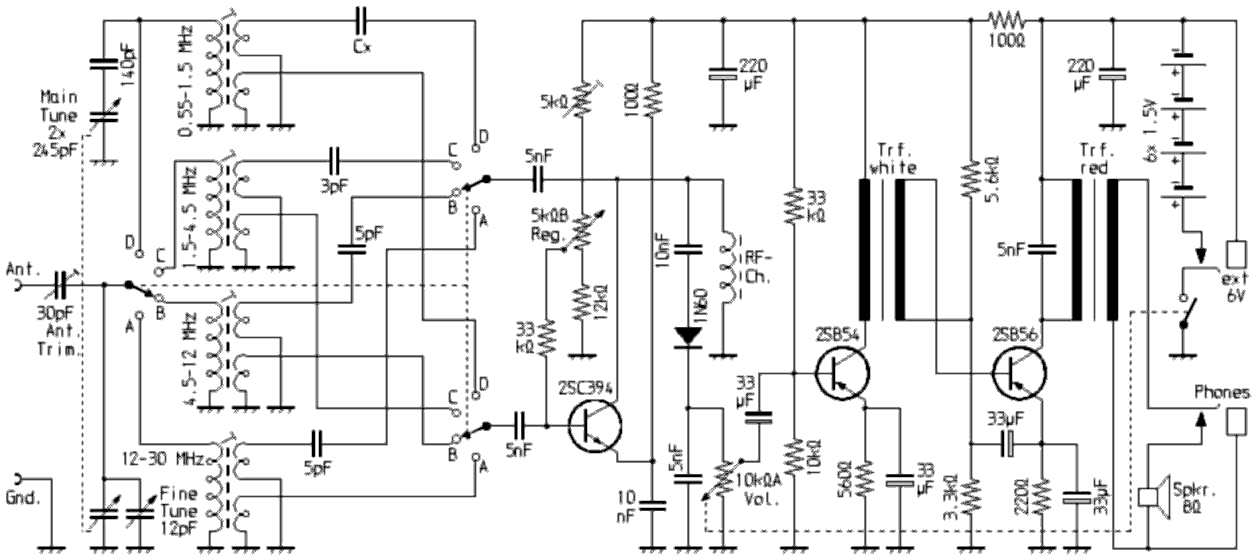The 'Science Fair Globe Patrol' receiver

This device is a Japanese-made regenerative receiver that was sold as a kit by the US electronics trading company Radio Shack (Tandy) in the early 1970s. Largely unknown in Europe, as a result it was possible to acquire a useful feedback receiver for receiving short and medium waves at a price of about 20 dollars, which did not burden the pocket money budget of a student too much. The device covers a continous reception range from 550 kHz to 30 MHz over four switchable wavebands. With feedback set shortly before the start of the oscillation, AM stations can be received with a usable selectivity. If the feedback is set so that the circuit begins to oscillate, the device - like all regenerative receivers - works as a kind of self-oscillating direct mixer. Since the device is equipped with main tuning and fine tuning and a mechanical fine drive is available, SSB and telegraph stations can be set to work well, especially on the lower short waves.
For example, advertisements for this device said:
Build yourself a world of excitement! Hear foreign broadcasts, Hams, CB, aviation and marine calls, regular AM stations. Battery powered 'Science Fair' kit gets 'em all. Band spread control, built-in speaker, earphone jack. Instructions include 'Where to Listen' guide. At our store near you. Or postpaid - add applicable post taxes.

At the time of appearance, the schematic like many Japanese products at the time had a rather conservative design. The germanium transistors in the audio part are particularly noticeable. But the transformer coupling enables the best power adjustment between the stages and to the loudspeaker. With the only two-stage amplifier arrangement, therefore, usable loudspeaker reception is still possible. The demodulation or mixing takes place with a germanium diode. An oscillator circuit with feedback according to Meißner is used for undamping respectively superposition. In the medium wave range, no feedback capacitor is shown in the original circuit diagram. However, since the regeneration regulator also works here, it must ultimately be exist. I assume that the feedback takes place here via the switching capacitance of the lines laid to the wave switch. The unknown capacity is designated here as Cx.
Unfortunately, the design makes the device rather unsuitable for replication without the kit, as the structural design and the nature of the coils and their coupling windings for feedback and adaptation to the transistor input have a decisive influence on the function. Nevertheless, considering the result, this extremely simple circuit is not uninteresting. The coupling to the antenna can be adjusted on the input side with a trimmer capacitor. For the best selectivity and stable SSB-CW reception, the coupling should be chosen so loosely that the required reception volume is just achieved.